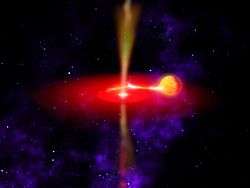GX 339-4
 GX 339-4 (artist's concept) | |
| Observation data Epoch J2000 Equinox J2000 | |
|---|---|
| Constellation | Ara |
| Right ascension | 17 02 49.5 |
| Declination | -48 47 23 |
| Characteristics | |
| Apparent magnitude (B) | 16.3 |
| Apparent magnitude (V) | 15.5 |
| Apparent magnitude (J) | 15.9 |
| Apparent magnitude (H) | 15.4 |
| Apparent magnitude (K) | 15.0 |
| Variable type | LMXB |
| Other designations | |
V821 Ara, 4U 1658-48, 3A 1659-487, 1RXS J170248.5-484719, 2MASS 17024936-4847228 | |
GX 339-4 is a moderately strong variable galactic low-mass X-ray binary (LMXB) source[1][2] and black-hole candidate that flares from time to time. From spectroscopic measurements, the mass of the black-hole was found to be at least of 5.8 solar masses.[3]
During the outbursts GX 339-4 shows evolution of quasi-periodic oscillations (QPOs). In the rising phase the QPO frequency monotonically increase as the CENBOL propagates closer to the black hole and in the declining phase the QPO frequency monotonically decreases since the CENBOL recedes away from the black hole after viscosity is decreased. The frequency variation is thus well modeled by the propagating and oscillating shock in the sub-Keplerian flow. The entire spectrum also fits very well using two component advective flow solution.
A strong, variable relativistic jet, emitting from radio to infrared wavelengths was observed by several studies.[4][5][6]
References
- ↑ SIMBAD
- ↑ Bradt, H.V.D., and McClintock, J.E., Annu. Rev. Astron. Astrophys., 21, 13-66 (1983)
- ↑ Hynes, R. I.; Steeghs, D.; Casares, J.; Charles, P. A.; O'Brien, K. (February 2003). "Dynamical Evidence for a Black Hole in GX 339-4". The Astrophysical Journal. 583 (2, pp. L95-L98.): L95–L98. arXiv:astro-ph/0301127
 . Bibcode:2003ApJ...583L..95H. doi:10.1086/368108.
. Bibcode:2003ApJ...583L..95H. doi:10.1086/368108. - ↑ Corbel, S.; Nowak, M. A.; Fender, R. P.; Tzioumis, A. K.; Markoff, S. (March 2003). "Radio/X-ray correlation in the low/hard state of GX 339-4". Astronomy and Astrophysics. 400: 1007–1012. arXiv:astro-ph/0301436
 . Bibcode:2003A&A...400.1007C. doi:10.1051/0004-6361:20030090.
. Bibcode:2003A&A...400.1007C. doi:10.1051/0004-6361:20030090. - ↑ Casella, P.; Maccarone, T. J.; O'Brien, K.; Fender, R. P.; Russell, D. M.; van der Klis, M.; Pe'Er, A.; Maitra, D.; Altamirano, D.; Belloni, T.; Kanbach, G.; Klein-Wolt, M.; Mason, E.; Soleri, P.; Stefanescu, A.; Wiersema, K.; Wijnands, R. (May 2010). "Fast infrared variability from a relativistic jet in GX 339-4". Monthly Notices of the Royal Astronomical Society: Letters. 404 (1, pp. L21-L25.): L21–L25. arXiv:1002.1233
 . Bibcode:2010MNRAS.404L..21C. doi:10.1111/j.1745-3933.2010.00826.x.
. Bibcode:2010MNRAS.404L..21C. doi:10.1111/j.1745-3933.2010.00826.x. - ↑ Gandhi, P.; Blain, A. W.; Russell, D. M.; Casella, P.; Malzac, J.; Corbel, S.; D'Avanzo, P.; Lewis, F. W.; Markoff, S.; Cadolle Bel, M.; Goldoni, P.; Wachter, S.; Khangulyan, D.; Mainzer, A. (October 2011). "A Variable Mid-infrared Synchrotron Break Associated with the Compact Jet in GX 339-4". The Astrophysical Journal Letters. 740 (1, article id. L13, 7 pp.): L13. arXiv:1109.4143
 . Bibcode:2011ApJ...740L..13G. doi:10.1088/2041-8205/740/1/l13.
. Bibcode:2011ApJ...740L..13G. doi:10.1088/2041-8205/740/1/l13.
External links
- http://iopscience.iop.org/1538-3881/123/3/1741: Optical Observations of the black hole candidate GX 339-4 Cowely et al.
- http://www.universetoday.com/89102/big-ol-black-hole-jets/: Big Ol’ Black Hole Jets